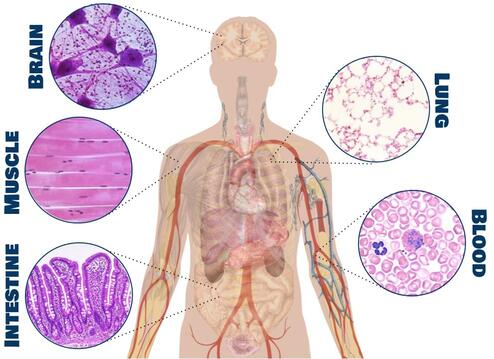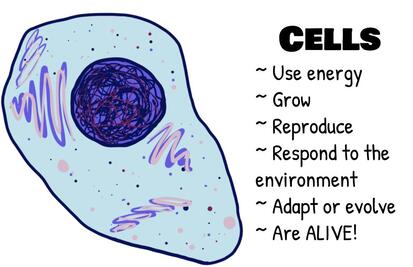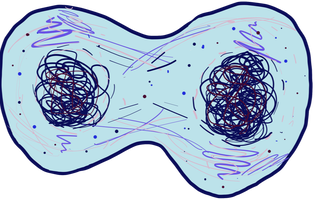What Are Cells?
We’ve been throwing around the word cell a lot this unit. After all, the name of the unit is “The Cell,” so that probably means they’re pretty important. So, it’s about time that we got around to defining what exactly we mean when we call something a cell.
Cells Are The Building Block of Life
A lot of people are vaguely familiar with the word “cell” and know that cells are really important in biology, but my guess is a lot of people (biologists included!) would have trouble defining “cell” beyond “the smallest structural unit of living things” or “the building block of life.” What does that really mean, though?
Well, when we say that cells are the smallest structural unit of living things, we mean that they are the smallest isolated unit that can be defined as alive. That is, they use energy, grow, reproduce, respond to the environment, and adapt or evolve. Molecules help the cell do these things, but the molecules themselves don’t do all of these. Smaller compartments in the cell do some of these things, but the individual compartments don’t do them themselves.
When we say that cells are the building block of life, we mean that all living things are made of cells, and cells can be put together kind of like Lego pieces to make up a complex organism with tissues, organs, and organ systems.
These definitions are 100% true, and if you understand this, then you already understand a pretty significant part of biology. But, these definitions are also pretty broad, and we want to help you understand biology on a much deeper level than just these recited definitions. To do this, we must dive a little bit into the history of a cell, to figure out how we ended up with such a broad definition to begin with.
Well, when we say that cells are the smallest structural unit of living things, we mean that they are the smallest isolated unit that can be defined as alive. That is, they use energy, grow, reproduce, respond to the environment, and adapt or evolve. Molecules help the cell do these things, but the molecules themselves don’t do all of these. Smaller compartments in the cell do some of these things, but the individual compartments don’t do them themselves.
When we say that cells are the building block of life, we mean that all living things are made of cells, and cells can be put together kind of like Lego pieces to make up a complex organism with tissues, organs, and organ systems.
These definitions are 100% true, and if you understand this, then you already understand a pretty significant part of biology. But, these definitions are also pretty broad, and we want to help you understand biology on a much deeper level than just these recited definitions. To do this, we must dive a little bit into the history of a cell, to figure out how we ended up with such a broad definition to begin with.
The History of Cell Theory
The term “cell” encompases everything from the simplest of bacteria to the highly complex neurons that make up your brain. There are a ton of different kinds of cells that have all kinds of different structures and functions, and no two cell types are exactly alike.
Part of the reason that we ended up including so many things in our definition of cells is because of how cells were originally discovered and named. This video gives a good overview (aside from the fact that the narrator keeps saying that cells are boring--lies!):
Part of the reason that we ended up including so many things in our definition of cells is because of how cells were originally discovered and named. This video gives a good overview (aside from the fact that the narrator keeps saying that cells are boring--lies!):
So, basically, in the late 1600’s, scientists were a really quirky bunch of people (okay, scientists are still a bit quirky… but in a cool way 😎) who got really excited about the cool new gizmos of the day and tended to get into silly arguments. It would make for a fascinating sitcom. Like The Big Bang Theory, except more Shakespearean. Out of this… quirkiness… arose some pretty remarkable discoveries, including cell theory. (Hey! That’s what we can call our sitcom!) Ultimately, cells were named cells because they looked kind of like cells in a monastery (or prison) under the not-very-good microscopes of the 1600’s.
Naturally, that’s going to leave us with a pretty broad category of stuff.
Naturally, that’s going to leave us with a pretty broad category of stuff.
Cell Theory
Actually, the definition of cells that they came up with based on the limited resources they had in those days is pretty impressive, and is still at the core of modern cell theory. To recap from the video, the 3 main points of cell theory are:
1. All living things are made of cells: you, your friends, the grass outside your house; one cell, two cell, red cell, blue cell: whether we’re talking about a complex organism made of many, many trillions of cells or a simple bacterium made of just one, all living things are made of cells. Though microscopically small, cells are incredibly important in serving as the building blocks of life.
1. All living things are made of cells: you, your friends, the grass outside your house; one cell, two cell, red cell, blue cell: whether we’re talking about a complex organism made of many, many trillions of cells or a simple bacterium made of just one, all living things are made of cells. Though microscopically small, cells are incredibly important in serving as the building blocks of life.
2. Cells are the basic unit of function in living things. In other words, all functions of living things can be traced back to something happening inside of a cell. Also, all cells do all of the functions needed to be considered a living thing (again: use energy, grow, reproduce, respond to the environment, adapt or evolve).
3. Cells come from other cells. Every cell comes from another cell. They’re much too complicated to just pop up out of nowhere all of the time. But, cells do reproduce to replace themselves. This is great news for life, because cells die all of the time. In fact, about 50 million cells in your body die every three seconds! The most common way that cells replace dead cells is through mitosis, which we’ll learn about later in this course.
You may now be asking: If all cells come from other cells, where
did the first cell come from? That is the question, indeed.*
did the first cell come from? That is the question, indeed.*
Cells Today
With modern knowledge of biochemistry, we now know that the functions of cells come down to the chemical reactions of molecules inside of them. But, cells are still hugely important (even though they’re really tiny 😄) because they bring all of these molecules together in a small enough space and in just the right type of environment that they can react in a way that is conducive to life. They’re like the perfect little test tubes for biochemistry.
So, what are cells? No two cell types are exactly alike, but cells are the smallest unit that can be considered alive, and all living things are made up of cells. They are microscopically small, and yet everything that life is, does, and can be comes down to what’s happening inside of cells. They are super-efficient factories for billions of complex biochemical reactions. And they are pretty dang cool, no matter what the mean video lady says.
So, what are cells? No two cell types are exactly alike, but cells are the smallest unit that can be considered alive, and all living things are made up of cells. They are microscopically small, and yet everything that life is, does, and can be comes down to what’s happening inside of cells. They are super-efficient factories for billions of complex biochemical reactions. And they are pretty dang cool, no matter what the mean video lady says.
Summary
You should understand:
- That cells are the smallest unit that can be independently defined as alive.
- That all living things are made of one or more cells.
- That cells (and the molecules they are made of) are the basic unit of function of living things.
- That all cells come from other cells.
Footnote
*Okay, so there is kind of an answer to this, but of course nobody knows for sure. Best-guess-to-date says that the first cell assembled from existing molecules (most likely RNA and a membrane at first) and got really good at doing living-thing stuff and reproducing, so cells just became a thing (in other words, it popped up out of nowhere, but probably over a very long period of time). If you’re really curious, this video gives a great overview, but it is definitely not required viewing for this course.
Learning Activity
Content contributors: Emma Moulton and Emily Zhang



